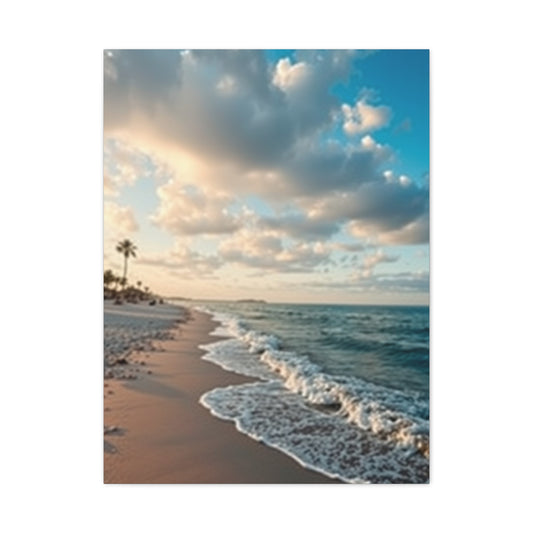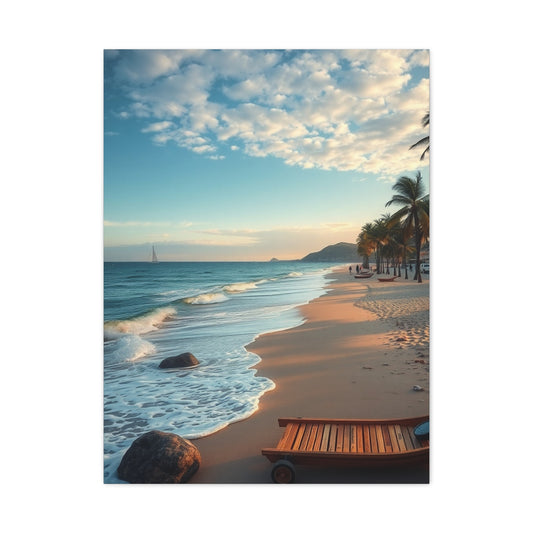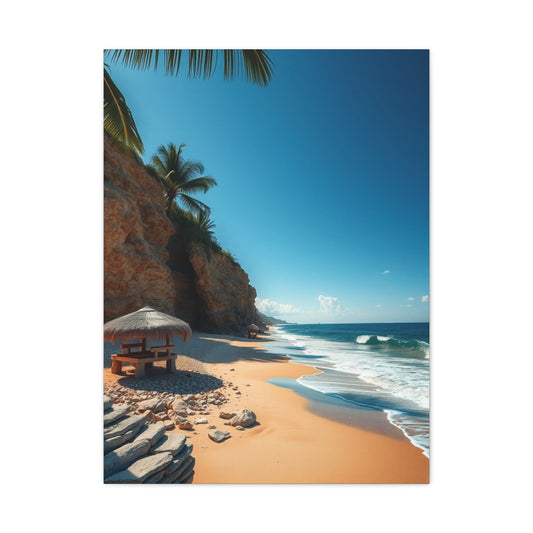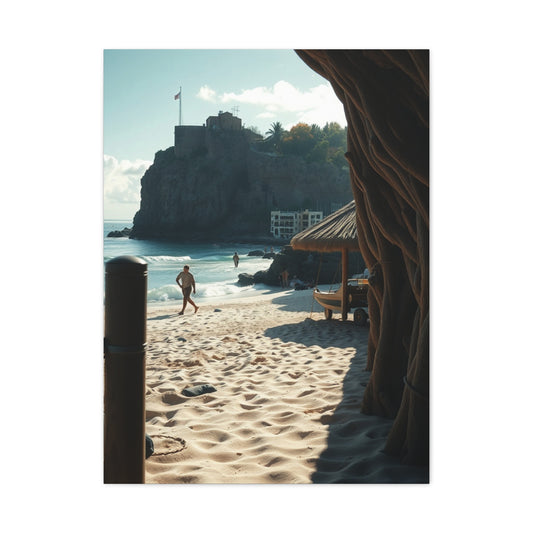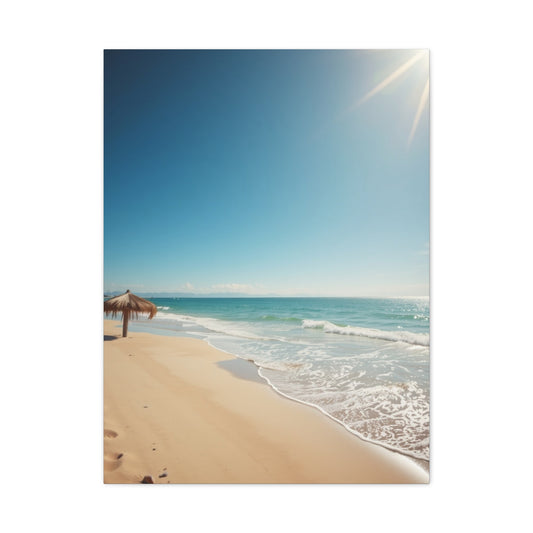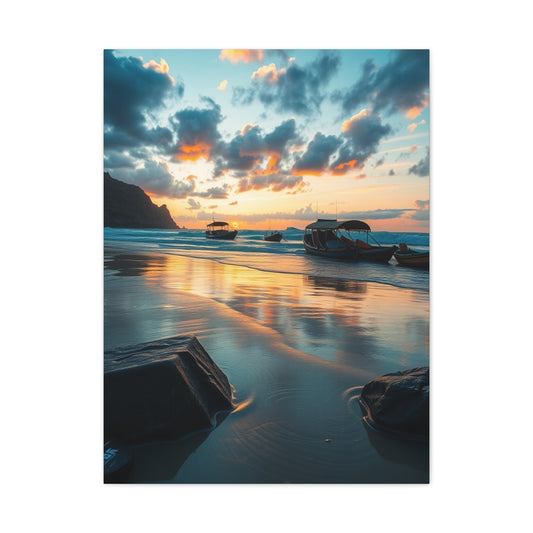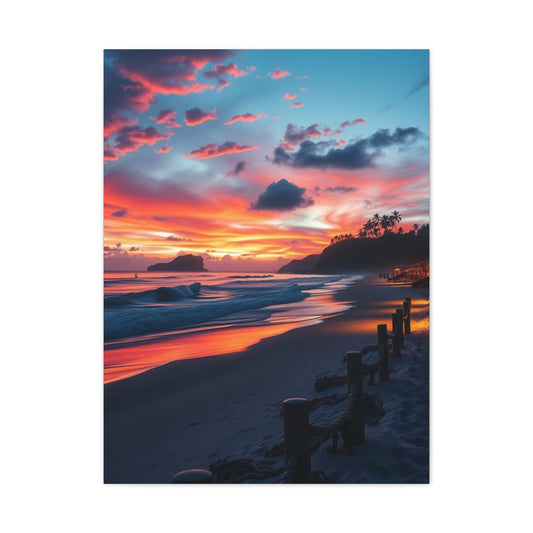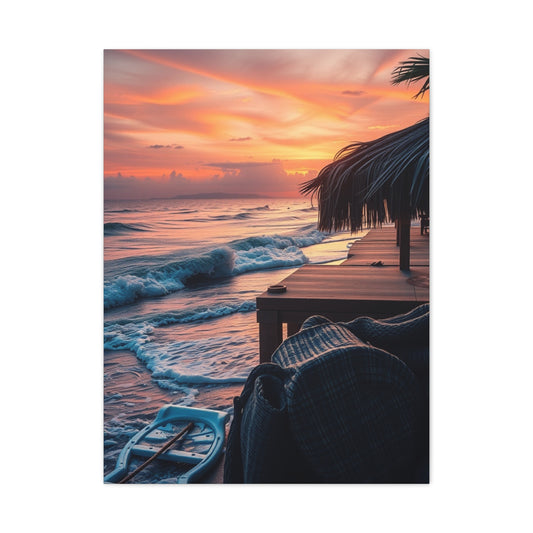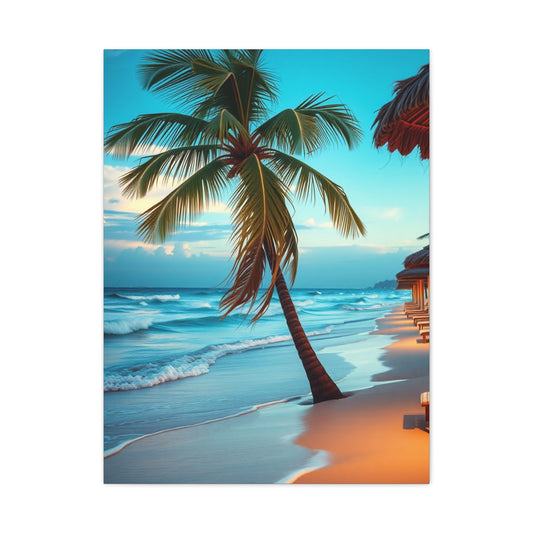Oceanic Masterpieces: Transforming Your Dwelling with Beach House Wall Art
Embark upon an extraordinary journey into the realm of maritime-inspired interior aesthetics, where the boundless majesty of oceanic vistas converges seamlessly with the intimate comfort of residential spaces. The integration of beach house wall art goes far beyond conventional decorative purposes, creating a meaningful connection between one’s personal sanctuary and the timeless allure of coastal environments. These visual narratives capture the subtle interplay of light, color, and motion found along the seashore, transforming walls into portals that evoke the serenity and grandeur of the ocean. Through careful curation, oceanic wall art not only enhances the physical environment but also cultivates an emotional resonance, allowing inhabitants to experience the restorative qualities of coastal landscapes without ever leaving the confines of their homes.
In today’s design-conscious society, homeowners seek more than simple ornamentation; they crave immersive experiences that elevate daily life and foster a sense of escape from the mundane pressures of routine. Beach house wall art fulfills this desire by serving as a conduit for transcendental journeys, providing daily exposure to the rhythmic dance of waves, the ethereal glow of maritime sunsets, and the infinite horizon where sky and sea converge in tranquil harmony. These carefully chosen pieces—ranging from traditional oil and watercolor paintings to modern digital prints and mixed-media installations—capture the dynamic energy and calming presence of the ocean, offering viewers both visual pleasure and psychological restoration.
Strategic placement and thoughtful selection are crucial in maximizing the transformative impact of coastal artwork. Larger canvases depicting expansive seascapes can dominate a living area, creating the illusion of open space and drawing the observer’s eye toward distant horizons. Smaller, intricately detailed pieces—such as driftwood-inspired sculptures or miniature nautical landscapes—can provide intimate focal points that invite prolonged contemplation. When arranged harmoniously within a room, these works establish a narrative that guides the viewer’s experience, integrating the natural rhythm of the sea with interior design principles such as balance, proportion, and color harmony.
Beyond aesthetic appeal, beach-themed wall art holds significant therapeutic potential. Scientific studies on biophilic design indicate that exposure to natural imagery—particularly water and coastal scenes—can reduce stress, enhance mood, and promote mental clarity. For residents of urban apartments or densely populated areas, incorporating ocean-inspired artwork becomes an essential strategy for bringing the calming influence of nature indoors. Even those living far from the coast can evoke the refreshing sensations of beach environments, creating an atmosphere of tranquility that fosters relaxation, reflection, and a sense of connection to the broader natural world.
Maritime Artistry: Infusing Residential Spaces with Aquatic Splendor
The contemporary appreciation for beach wall art emanates from humanity's primordial connection to aquatic environments, where the rhythmic cadence of crashing waves evokes profound emotional responses that transcend cultural and geographical boundaries. These artistic expressions serve as visual symphonies, orchestrating harmonious compositions that celebrate the dynamic interplay between terrestrial comfort and maritime adventure. Each carefully crafted piece functions as a portal, inviting inhabitants to experience the rejuvenating energy of coastal landscapes without departing from their cherished domestic environments.
Coastal living room art has evolved significantly beyond traditional seashell collections and nautical rope displays, embracing sophisticated aesthetic philosophies that honor the ocean's multifaceted personality. Contemporary interpretations incorporate avant-garde techniques, experimental color palettes, and innovative compositional structures that capture the essence of marine environments while maintaining relevance within modern interior design paradigms. The proliferation of sea inspired paintings reflects society's growing appreciation for environmental consciousness and the therapeutic benefits associated with natural imagery.
The psychological impact of beach themed wall art extends far beyond superficial visual appeal, establishing neurological pathways that promote relaxation, creativity, and emotional equilibrium. Research in environmental psychology demonstrates that exposure to oceanic imagery can reduce cortisol levels, lower blood pressure, and enhance cognitive function through activation of parasympathetic nervous system responses. These physiological benefits transform beach house wall art from mere decoration into essential components of holistic wellness strategies.
Seascape canvas art represents the pinnacle of technical mastery, requiring artists to capture the ephemeral qualities of light refracting through water droplets, the translucent depths of turquoise lagoons, and the explosive power of storm-tossed breakers. Master practitioners of this medium possess intimate understanding of atmospheric conditions, tidal patterns, and seasonal variations that influence coastal environments throughout annual cycles. Their expertise manifests in paintings that achieve photorealistic precision while maintaining artistic interpretation that elevates documentation into transcendent aesthetic experiences.
Embracing Elemental Forces Through Artistic Expression
Coastal art decor represents a rich and multifaceted arena within contemporary interior design, encompassing a broad spectrum of stylistic approaches that reflect diverse philosophical perspectives on humanity’s connection with marine environments. At its core, coastal artwork captures the eternal dialogue between land, sea, and sky, translating the elemental forces of nature into visual narratives that resonate deeply with viewers. Traditional interpretations often emphasize the romantic idealization of seaside tranquility, portraying gentle waves caressing pristine beaches beneath cloudless skies or capturing the delicate interplay of sunlight upon calm waters. Such works celebrate serenity, nostalgia, and the restorative qualities of natural landscapes, inviting audiences to pause and immerse themselves in moments of contemplative reflection.
In contrast, contemporary coastal art increasingly interrogates environmental realities, offering provocative commentaries on the fragility of marine ecosystems, climate change impacts, and human-induced environmental stress. These modern interpretations challenge viewers to engage intellectually as well as aesthetically, blending emotive storytelling with visual sophistication. Artists experiment with unconventional compositions, exaggerated forms, and symbolic color palettes to emphasize ecological vulnerability, forging works that are not merely decorative but ethically and socially resonant. By juxtaposing beauty with urgency, these creations foster awareness while simultaneously maintaining the aesthetic appeal that draws collectors, interior designers, and casual admirers alike.
The evolution of ocean sunset art exemplifies the innovative potential within established thematic frameworks. While sunsets have long served as a classic subject, contemporary painters reinterpret them using bold color harmonies, dramatic perspectives, and experimental brushwork that reinvigorate traditional maritime imagery. These artistic explorations push the boundaries of visual storytelling, allowing familiar subjects to convey novel emotional and atmospheric experiences. In doing so, artists honor the legacy of classical maritime painting while simultaneously advancing contemporary sensibilities, creating a dialogue between tradition and experimentation that enriches both the creative and cultural significance of coastal art.
Wave wall art has emerged as a particularly dynamic subcategory within coastal decor, offering unparalleled opportunities to explore motion, energy, and temporal fluidity through static media. The inherent challenge of rendering perpetual movement within a fixed composition demands exceptional technical skill, as artists must capture the ever-changing dynamics of foam, spray, and subsurface currents with precision and intuition. Successful practitioners often develop signature techniques that allow viewers to perceive kinetic energy frozen in its peak intensity, conveying the tactile force of the ocean in ways that evoke both admiration and emotional resonance. Such works exemplify the capacity of coastal art to communicate the power and majesty of elemental forces while maintaining the intimate connection of home and personal space.
Modern coastal painting galleries highlight the stylistic diversity of oceanic themes, ranging from hyperrealistic documentary studies to abstract emotional interpretations that distill the essence of the sea into pure color, form, and movement. This diversity ensures that coastal wall art integrates seamlessly with a wide range of interior design aesthetics, from minimalist Scandinavian apartments emphasizing clean lines and subtle hues to eclectic maximalist spaces rich in texture and layered narratives. The universal appeal of the ocean, with its symbolic associations of freedom, renewal, and infinity, transcends cultural and geographic boundaries, making beach house wall art a versatile choice for residential, commercial, and international applications.
Ultimately, the enduring fascination with coastal art stems from its ability to blend aesthetic beauty with conceptual depth. By embracing elemental forces through artistic expression, coastal artwork provides viewers with opportunities for visual delight, intellectual engagement, and emotional reflection. Whether displayed as a focal point in a modern living room, a serene accent in a seaside retreat, or a dramatic statement in a public gallery, these artworks capture the spirit of the ocean and transform spaces into immersive, meaningful environments. Through the thoughtful curation and appreciation of coastal art, homeowners and art enthusiasts alike can forge enduring connections to the natural world, ensuring that the majesty, mystery, and transformative power of maritime landscapes remain present in daily life.
Littoral Landscapes:
Beach scene paintings require artists to synthesize multiple environmental elements into coherent compositional narratives that communicate specific atmospheric conditions, seasonal characteristics, and geographical locations. Successful practitioners develop encyclopedic knowledge of coastal ecosystems, studying vegetation patterns, geological formations, wildlife behaviors, and meteorological phenomena that contribute to authentic regional representations. This scholarly approach elevates beach themed wall art beyond generic tourist imagery into sophisticated cultural documentation.
The emotional resonance of textured wave wall art derives from tactile qualities that invite physical interaction alongside visual contemplation. Artists employ various techniques including impasto applications, mixed media assemblages, and three-dimensional relief elements that create haptic experiences engaging multiple sensory modalities simultaneously. These innovations transform traditional two-dimensional wall art into immersive installations that occupy architectural space through physical projection and atmospheric presence.
Large sea wave painting installations command attention through sheer scale, creating dramatic focal points that anchor entire room compositions while establishing hierarchical relationships between primary and secondary decorative elements. The psychological impact of oversized oceanic imagery relates to humanity's evolutionary responses to natural grandeur, triggering awe reactions that promote contemplative states and philosophical reflection. These monumental works function as modern secular altars dedicated to natural beauty and environmental reverence.
Professional interior designers increasingly recognize the versatility of sea inspired paintings as foundational elements capable of unifying disparate decorative components into cohesive aesthetic statements. The inherent color palettes found within maritime imagery provide natural coordination points for textile selections, furniture choices, and architectural accent decisions. This practical utility combines with emotional appeal to establish oceanic artwork as indispensable tools within contemporary design vocabularies.
Exploring Conceptual Depths Through Visual Metaphor
Abstract ocean art challenges viewers to engage intellectually with oceanic concepts rather than relying solely upon literal recognition of familiar coastal imagery. These sophisticated interpretations distill maritime experiences into essential emotional and philosophical components, creating opportunities for personal projection and subjective interpretation that enhance long-term viewing satisfaction. The ambiguity inherent within abstract compositions prevents aesthetic fatigue while encouraging ongoing discovery of previously unnoticed details and relationships.
Contemporary ocean artwork for home environments must balance artistic integrity with practical considerations including color coordination, scale appropriateness, and maintenance requirements. Professional artists working within residential markets develop expertise in creating pieces that maintain visual impact while complementing existing decorative schemes. This commercial awareness enhances rather than compromises artistic vision, challenging creators to achieve maximum aesthetic effect within specific parametric constraints.
The therapeutic applications of beach house wall art extend into clinical environments, where healthcare facilities increasingly incorporate oceanic imagery to promote patient comfort and accelerate healing processes. Research demonstrates that exposure to nature-based artwork reduces anxiety, pain perception, and recovery times across diverse medical specialties. These findings validate ancient wisdom regarding nature's healing properties while providing scientific justification for strategic artwork placement within therapeutic environments.
Large ocean canvas installations present unique technical challenges related to structural support, environmental protection, and installation logistics. Professional conservators collaborate with artists to develop mounting systems that preserve artwork integrity while ensuring viewer safety and building code compliance. These collaborative efforts result in permanent installations capable of withstanding decades of environmental exposure while maintaining original aesthetic impact.
Curating Collections That Celebrate Maritime Heritage
Curating a collection of beach-themed wall art involves a meticulous process that balances aesthetic appeal, spatial harmony, and thematic coherence. Selecting the right pieces requires careful consideration of multiple factors, including room dimensions, lighting conditions, existing color schemes, and the desired emotional or atmospheric effects. A single painting or sculptural installation can dramatically transform the perception of a room, creating focal points, enhancing depth, or evoking a sense of tranquility inspired by the ocean. Professional design consultants employ systematic approaches to evaluate artwork compatibility, examining how individual pieces interact with architectural elements such as wall textures, window placements, and furniture layouts. By understanding these dynamics, curators can ensure that each selection not only complements the surrounding environment but also contributes to an overarching narrative that resonates with viewers.
The appeal of coastal art extends beyond purely decorative purposes, finding applications in educational and institutional settings. Schools, universities, and research facilities increasingly integrate sea-inspired paintings into curriculum-supporting environments, where they enrich learning experiences across multiple disciplines. For example, marine biology laboratories benefit from hyperrealistic depictions of ecosystems, coral reefs, and oceanic species, which enhance observational skills and provide visual context for scientific study. Literature and art classrooms often utilize symbolic maritime imagery to explore themes of adventure, exploration, and human relationships with nature, fostering intellectual engagement and inspiring creative discourse. These pedagogical applications demonstrate that coastal art functions as both an aesthetic and educational tool, bridging the gap between visual pleasure and cognitive enrichment.
The conservation of historical beach house wall art represents a specialized field within cultural heritage preservation. Maintaining the integrity of maritime artworks requires in-depth knowledge of traditional painting techniques, materials, and environmental factors that can accelerate deterioration, such as humidity, salt exposure, and ultraviolet light. Museum professionals, private collectors, and conservation specialists collaborate to implement restoration strategies that respect the original artistic intent while ensuring long-term stability. This stewardship extends beyond individual ownership, reflecting a broader responsibility to safeguard cultural heritage and maintain access to thalassic treasures for future generations. In this way, each preserved piece serves as a tangible connection to maritime history, artistic tradition, and the enduring human fascination with the sea.
The commercial landscape surrounding coastal art continues to expand, fueled by rising demand in international markets. Specialized galleries, auction houses, and certification programs have emerged to meet the needs of collectors seeking authentic, investment-quality pieces. These infrastructures not only provide platforms for established artists to reach global audiences but also support emerging practitioners by offering exposure, professional development opportunities, and sustainable career pathways within the maritime art niche. Beyond the art market itself, this economic ecosystem benefits coastal communities through cultural tourism, educational workshops, and public exhibitions, reinforcing the symbiotic relationship between art, commerce, and regional identity.
Ultimately, curating and preserving beach-themed wall art is a multidimensional endeavor that encompasses design strategy, educational impact, cultural stewardship, and economic vitality. The process of selecting, displaying, and maintaining maritime artwork transforms residential and institutional spaces into immersive environments that celebrate the beauty, power, and mystery of the sea. From intimate private collections to grand public installations, coastal art serves as a conduit for emotional resonance, intellectual exploration, and cultural continuity. By fostering thoughtful curation, supporting professional conservation, and cultivating sustainable market structures, the artistic community ensures that thalassic treasures remain vibrant, meaningful, and accessible for generations to come.
Pelagic Panoramas:
The integration of digital technology with traditional beach wall art creates hybrid experiences that combine static imagery with dynamic elements including ambient sound recordings, changing lighting effects, and interactive components. These innovations extend artistic boundaries while maintaining connection to oceanic themes that define coastal art decor. Technology-enhanced installations particularly appeal to younger generations while preserving appreciation for maritime artistic traditions.
Seasonal rotation of ocean artwork for home environments allows residents to experience varied atmospheric conditions and emotional tones throughout annual cycles. Spring installations might emphasize renewal themes through gentle surf and emerging marine life, while autumn pieces could explore storm dynamics and dramatic weather patterns. This curatorial strategy prevents visual stagnation while celebrating the dynamic character of coastal environments across temporal dimensions.
The globalization of artistic styles has introduced diverse cultural perspectives into traditional coastal art decor frameworks, enriching thematic possibilities while expanding market appeal. Japanese wave painting traditions influence contemporary Western seascape compositions, while Caribbean color sensibilities inspire Nordic maritime artists working within cooler climatic contexts. These cross-cultural fertilizations yield innovative hybrid styles that reflect increasingly interconnected global artistic communities.
Professional lighting design plays crucial roles in maximizing the impact of sea inspired paintings through strategic illumination that enhances color saturation, textural details, and atmospheric qualities. Specialized museum lighting systems adapted for residential applications protect artwork while creating optimal viewing conditions throughout daily lighting cycles. These technical considerations transform passive wall decorations into active components of architectural lighting schemes.
Abyssal Artistry:
The exploration of deep ocean themes within beach house wall art introduces mysterious elements that balance familiar coastal imagery with unknown aquatic realms. Artists working within these thematic territories draw inspiration from scientific discoveries, mythological traditions, and speculative fiction to create compositions that suggest vast underwater landscapes rarely experienced directly. These mysterious qualities add psychological depth that encourages ongoing contemplation and discovery.
Collaborative projects between marine scientists and coastal artists yield educational artworks that communicate scientific concepts through aesthetically engaging media. Climate change documentation, species preservation advocacy, and oceanographic research findings gain broader public awareness through artistic interpretation that makes complex information accessible to general audiences. These partnerships demonstrate art's capacity for social engagement beyond purely aesthetic functions.
The restoration of historical coastal environments provides inspiration for contemporary beach themed wall art that documents lost or endangered marine ecosystems. Artists serve as cultural historians, preserving visual records of environmental conditions that may disappear due to human impact or natural changes. These documentary functions establish artistic works as valuable scientific and cultural resources that transcend decorative applications.
Architectural integration of large sea wave painting installations requires collaboration between artists, structural engineers, and building contractors to achieve safe, permanent placements that enhance rather than compete with surrounding spatial elements. These interdisciplinary projects demonstrate art's capacity to function as integral architectural components that define rather than merely decorate interior environments.
Capturing Light's Dance Across Aquatic Surfaces
The technical mastery required for convincing ocean sunset art involves understanding complex optical phenomena including light refraction, atmospheric scattering, and surface reflection patterns that create the spectacular visual effects associated with maritime twilight conditions. Artists studying these subjects develop observational skills comparable to meteorologists while maintaining aesthetic sensibilities necessary for compelling artistic interpretation.
Color theory applications within coastal art decor extend beyond simple palette selection toward sophisticated understanding of psychological color responses, cultural color associations, and environmental color relationships that influence viewer emotional states. Professional practitioners develop personal color vocabularies that distinguish their work while maintaining thematic coherence across diverse compositional contexts.
The preservation of fade-resistant pigments in wave wall art requires knowledge of chemical stability, UV protection strategies, and environmental control systems that prevent deterioration while maintaining original color relationships. Conservation scientists collaborate with artists to develop materials and techniques that ensure longevity without compromising aesthetic quality or creative freedom.
Exhibition design principles adapted for residential installations help homeowners create gallery-quality displays that honor artistic merit while integrating seamlessly with domestic living requirements. Professional installation services ensure proper mounting, lighting, and spatial relationships that maximize visual impact while protecting valuable artworks from environmental damage or accidental harm.
Storytelling Through Maritime Visual Languages
Contemporary maritime wall art, particularly textured wave installations, represents a dynamic fusion of artistic innovation and oceanic inspiration. Artists increasingly employ mixed media techniques that combine traditional painting with sculptural elements, found objects, and alternative materials, creating works that engage both the visual and tactile senses. These experimental approaches allow for greater expressive possibilities, enabling creators to capture the fluidity, energy, and complexity of the sea in ways that conventional painting alone cannot. By incorporating elements such as driftwood, sand, shells, and metallic accents, textured wave art transforms static surfaces into immersive experiences, inviting viewers to explore depth, motion, and material interplay. This evolution demonstrates a careful balance between honoring established thematic frameworks and pushing the boundaries of aesthetic exploration, resulting in pieces that are both visually compelling and conceptually rich.
The psychological and emotional impact of large ocean-themed canvases has been validated through research in biophilic design, which emphasizes humanity’s innate affinity for natural environments. Studies show that exposure to oceanic imagery stimulates neural pathways associated with relaxation, creativity, and emotional restoration, highlighting the profound ways in which art can influence mental well-being. Coastal artwork can serve as a sanctuary within domestic and professional spaces, providing a sense of calm and rejuvenation amidst the pressures of daily life. Large-format wave canvases, with their sweeping compositions and evocative color schemes, are particularly effective in creating immersive environments that engage the senses, encourage mindfulness, and support creative thinking. The incorporation of nature-inspired artwork into interior spaces thus offers both aesthetic value and scientifically supported benefits, reinforcing its significance in contemporary design practices.
Professional appraisal and valuation of beach house wall art represents another critical facet of maritime art stewardship. Certified appraisers must possess deep knowledge of artistic techniques, historical significance, market trends, and environmental factors that affect the preservation and value of artwork. Understanding how mediums respond to coastal conditions, the provenance of pieces, and the broader dynamics of the art market allows professionals to provide accurate assessments for collectors, investors, and insurers. Maritime art occupies a unique niche within the global art ecosystem, blending heritage, cultural symbolism, and commercial potential. Expert appraisal ensures that collectors make informed decisions while safeguarding investments, preserving the integrity of artistic traditions, and supporting sustainable career pathways for contemporary artists.
Beyond collection and appraisal, educational programs and workshops play an increasingly important role in fostering engagement with maritime art. These initiatives provide amateur and emerging artists with opportunities to develop technical skills, explore creative techniques, and deepen appreciation for oceanic environments. Workshops often incorporate multidisciplinary approaches, including field studies of coastal landscapes, discussions on conservation practices, and examinations of cultural and historical maritime influences. By connecting hands-on creation with environmental awareness and artistic heritage, these programs cultivate a holistic understanding of coastal art, encouraging participants to see beyond mere decoration and recognize the broader significance of ocean-inspired visual expression.
Ultimately, storytelling through maritime visual languages underscores the transformative potential of coastal art. Textured wave pieces, immersive canvases, and mixed-media innovations allow artists to convey the power, beauty, and fragility of the ocean in ways that engage viewers on aesthetic, intellectual, and emotional levels. Whether appreciated in private homes, public galleries, or educational settings, beach-themed art provides a multidimensional experience that fosters relaxation, inspires creativity, and reinforces humanity’s enduring connection to the natural world. By combining innovative artistic techniques, scientifically supported psychological benefits, expert appraisal, and educational initiatives, the field of maritime visual art ensures that oceanic beauty continues to enrich, educate, and inspire audiences across generations.
The incorporation of scientific accuracy into abstract ocean art represents a unique convergence of aesthetic innovation and environmental education. Contemporary artists increasingly collaborate with marine biologists and environmental scientists to create works that capture not only the beauty of the sea but also the intricacies of oceanic ecosystems. These collaborations allow artwork to communicate accurate ecological information, illustrating phenomena such as coral reef biodiversity, pelagic species behavior, and ocean currents. By combining visual appeal with scientific rigor, such art fosters public understanding of marine conservation challenges, climate change impacts, and ongoing research discoveries, transforming private or public spaces into immersive environments for both intellectual engagement and aesthetic enjoyment. In this way, bathypelagic-inspired artwork transcends traditional decorative roles, becoming a powerful educational tool that bridges the gap between science and culture.
Sustainable practices within coastal art decor further enhance the relevance and impact of maritime-themed collections. Responsible material selection, including the use of recycled canvases, non-toxic paints, and ethically sourced natural elements, reduces environmental footprints while maintaining high artistic quality. Energy-efficient production methods and eco-conscious framing solutions demonstrate that artistic creativity can coexist with environmental responsibility. Many artists and galleries also actively participate in fundraising initiatives or conservation campaigns aimed at protecting marine habitats, reinforcing the social value of coastal art. These efforts resonate particularly with environmentally conscious consumers, who seek décor that aligns with personal values, ensuring that artwork embodies ethical as well as aesthetic significance. The integration of sustainability into artistic practice highlights the capacity of visual art to contribute positively to society beyond its decorative function.
The therapeutic potential of ocean-themed art is increasingly recognized across diverse settings, from residential interiors to specialized healthcare environments. Large-scale wave paintings, serene seascapes, and abstract maritime compositions are incorporated into rehabilitation centers, elder care institutions, and mental health clinics, where exposure to coastal imagery promotes relaxation, emotional restoration, and cognitive engagement. Professional art therapists design treatment protocols that actively leverage these artworks, using visual narratives of oceanic environments to reduce stress, stimulate memory recall, and encourage reflective experiences. In these contexts, ocean-inspired decor functions as more than visual ornamentation; it becomes a vital component of healing strategies that integrate aesthetics with psychology, illustrating the multidimensional value of well-curated maritime art collections.
International acquisition and transport of large-scale maritime artwork introduces additional complexities that require expert logistical planning. Artwork shipments demand careful attention to customs regulations, insurance coverage, climate control during transit, and specialized handling protocols to prevent damage or deterioration. Professional art logistics services provide expertise in navigating these challenges, ensuring that delicate textures, layered paints, and sculptural elements remain intact from the point of purchase to final installation. These services are particularly critical for high-value oceanic pieces, where preservation of both artistic integrity and financial investment is paramount. Effective coordination of these processes guarantees that collectors, galleries, and institutions can enjoy maritime art in optimal condition, maintaining its aesthetic, educational, and emotional impact.
Ultimately, bathypelagic-inspired art exemplifies the intersection of aesthetic expression, environmental responsibility, and societal enrichment. By blending artistic creativity with scientific accuracy, sustainable practices, therapeutic applications, and professional logistics, coastal wall art fulfills multiple roles beyond simple decoration. These works connect viewers with the vastness and complexity of the ocean, inspire ecological awareness, and provide emotional and cognitive benefits in a range of settings. Through thoughtful curation, ethical production, and careful preservation, bathypelagic beauty ensures that maritime-inspired artwork continues to enrich homes, institutions, and public spaces alike, offering enduring inspiration and education for generations to come.
Epilogic Elegance:
The transformative power of beach house wall art extends far beyond conventional decorative boundaries, establishing profound connections between human consciousness and the eternal rhythms of oceanic environments. This comprehensive exploration has illuminated the multifaceted nature of coastal art decor, revealing sophisticated aesthetic philosophies, technical innovations, and therapeutic applications that elevate maritime imagery into essential components of contemporary living spaces. The journey through various artistic interpretations demonstrates how sea inspired paintings function as more than mere ornamentation, serving as portals to transcendent experiences that nourish the soul while enhancing architectural environments.
The evolution of ocean wall art reflects broader cultural shifts toward environmental consciousness, wellness-focused lifestyle choices, and appreciation for natural beauty that transcends temporal fashion trends. Beach themed wall art has emerged as a timeless aesthetic choice that remains perpetually relevant while adapting to changing artistic movements and technological innovations. This enduring appeal stems from humanity's primordial connection to aquatic environments, where the rhythmic dance of waves provides comfort, inspiration, and spiritual renewal that speaks to fundamental aspects of human nature.
Contemporary collectors of coastal art decor participate in cultural preservation efforts that extend beyond personal aesthetic enjoyment toward stewardship of artistic heritage and environmental advocacy. Their investment choices support emerging artists while maintaining demand for traditional techniques that might otherwise disappear under pressure from digital alternatives. This collector consciousness demonstrates how private art acquisition contributes to broader cultural sustainability initiatives that benefit entire artistic communities.
The future trajectory of wave wall art promises continued innovation through integration of emerging technologies, exploration of new materials, and evolution of thematic interpretations that reflect changing relationships between humanity and oceanic environments. Climate change documentation, conservation advocacy, and scientific collaboration will likely influence artistic directions while maintaining the fundamental appeal of maritime beauty that defines this artistic category.
Professional interior designers increasingly recognize seascape canvas art as foundational elements capable of anchoring comprehensive decorative schemes while providing flexible coordination points for seasonal updates and style evolution. The practical versatility of oceanic color palettes ensures long-term relevance within changing design trends, making beach house wall art sound investment choices for both aesthetic and financial considerations.
The global appreciation for ocean artwork for home environments demonstrates art's capacity to transcend cultural boundaries while maintaining local relevance through regional interpretations of universal themes. International artistic exchange enriches coastal art decor through diverse stylistic influences while preserving distinct cultural perspectives that contribute to the medium's continued vitality and evolution.
Educational institutions, healthcare facilities, and commercial establishments increasingly incorporate large ocean canvas installations as integral architectural elements that support institutional missions while creating welcoming environments for diverse user populations. These applications demonstrate art's capacity to function beyond purely aesthetic roles toward active contributions to human welfare and organizational success.
Conclusion:
The conservation challenges associated with protecting valuable coastal artwork are complex and multifaceted, demanding ongoing collaboration between artists, scientists, and preservation specialists. Coastal and beach-themed art is particularly vulnerable to environmental stressors such as salt spray, humidity, temperature fluctuations, and intense sunlight, which can accelerate the deterioration of pigments, canvases, and other materials. As a result, preservation requires not only traditional conservation techniques but also the development of innovative methods that anticipate and mitigate these risks over decades of exposure. Scientists contribute critical knowledge regarding the chemical and physical stability of materials in marine-influenced environments, while artists and curators provide insight into aesthetic priorities, ensuring that the artwork retains its original vision and expressive power. Together, these interdisciplinary teams are establishing protocols that safeguard both the artistic integrity of individual pieces and the long-term accessibility of ocean-inspired art for future generations.
In this context, beach house wall art serves a dual purpose: it enriches interior spaces while reinforcing cultural connections to the natural world. These works act as bridges between urban lifestyles and the coastal environment, offering viewers daily reminders of the beauty, serenity, and vastness of the sea. Beyond decorative appeal, such art encourages emotional and psychological engagement with marine landscapes, fostering mindfulness, creativity, and a deeper appreciation for the interconnectedness of human life and natural ecosystems. This ability to evoke emotional resonance and cultural reflection underscores the enduring value of coastal-themed artwork in contemporary interior design, whether displayed in private residences, boutique hotels, or public spaces.
Moreover, the realm of oceanic artistic expression continues to expand through technological innovation and cultural exchange. Digital printing, mixed media, and sustainable materials allow artists to experiment with new forms while maintaining environmental responsibility. Cross-cultural influences further enrich the thematic diversity of beach-inspired art, blending traditional maritime imagery with modern interpretations that reflect contemporary social and ecological concerns. This dynamic evolution ensures that beach and coastal art remains relevant to a wide audience, resonating with collectors, interior designers, and casual admirers alike.
Importantly, these maritime masterpieces also play a role in broader environmental consciousness. By celebrating the majesty of oceans, beaches, and coastal landscapes, artists help raise awareness about environmental preservation, climate change, and marine biodiversity. Viewers are invited to reflect on humanity's relationship with nature and the urgent need to protect fragile ecosystems. In this way, the art serves not only as a visual delight but also as an instrument of education, advocacy, and cultural enrichment.
Ultimately, the continued creation, display, and preservation of beach-themed wall art exemplify the synergy between artistic innovation and environmental stewardship. Each piece, whether an intimate canvas in a residential bathroom or a grand-scale installation in a public gallery, conveys a narrative that links human experience with the rhythms of the natural world. These works remind us of the infinite beauty surrounding our planet and inspire ongoing exploration of artistic possibilities within a theme that remains eternally relevant. By fostering collaboration among artists, scientists, and conservators, the art community ensures that the legacy of coastal artwork will endure, allowing future generations to enjoy and be inspired by these visual celebrations of the sea.

